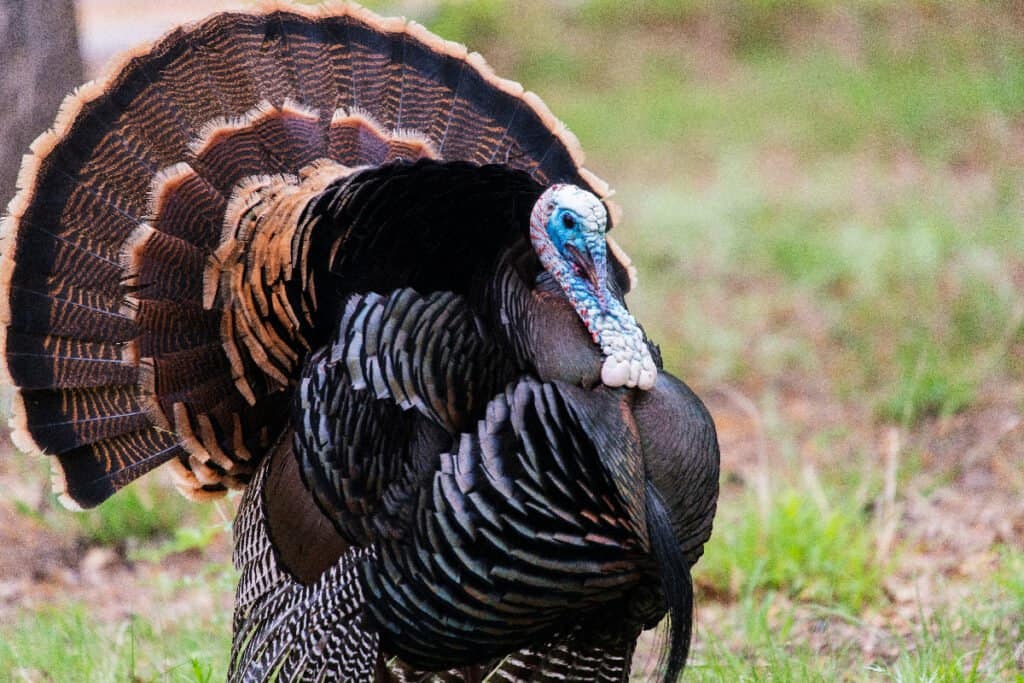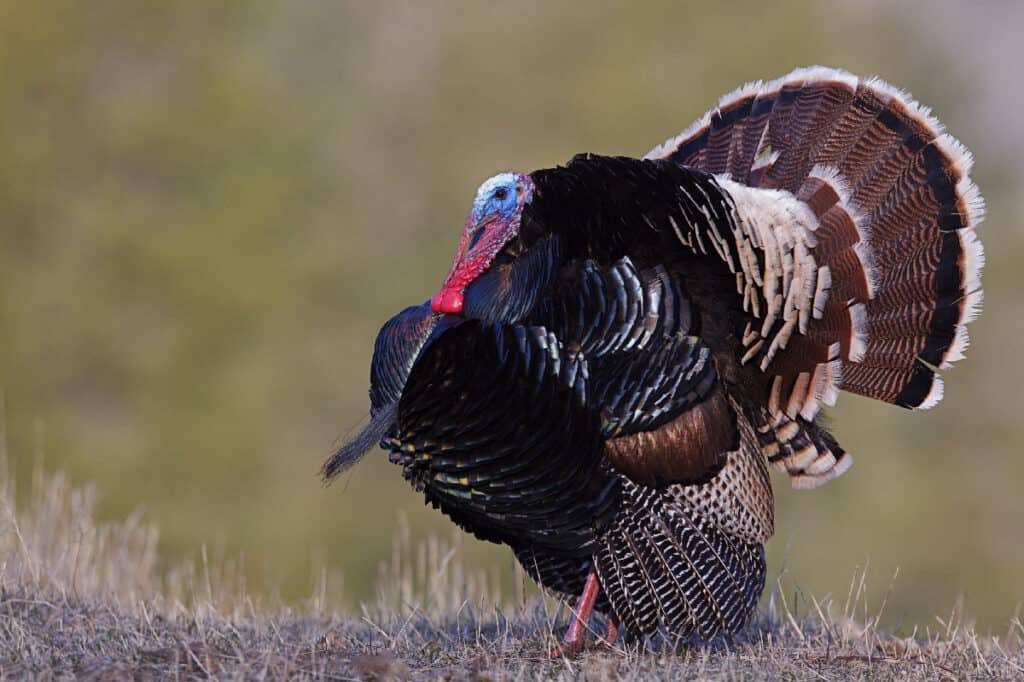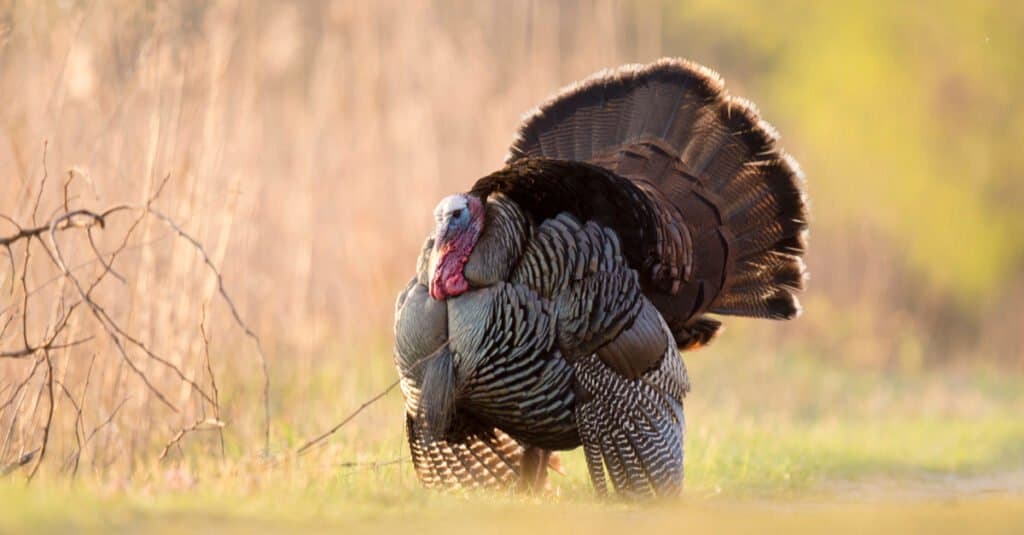The turkey is a giant bird, from the Aves class, native to North America. There are two primary species, namely the common turkey(wild and domesticated ones) and the ocellated turkey. They have a nationwide significance to the citizens of the United States as they make up the customary Thanksgiving dish.
Besides being the perfect meat for Thanksgiving, here are 10 other facts about turkeys that may amaze you:
1. Wild And Domesticated Turkeys Are The Same Species

There are only two species of turkeys.
©Brent Coulter/Shutterstock.com
There are wild and domesticated turkeys and while you may be tempted to think they are different species, they are the same and they have the same scientific name- Meleagris gallopavo. However, owing to their different habitats, there are ostensible differences between them. For starters, domestic turkeys have white feathers, while the wild ones have darker feathers fit for camouflaging in their wild habitats.
Wild birds are also much slimmer and nimbler than the domesticated ones, which is expected since the latter are bred to accumulate weight. The domestic turkeys also have much less genetic variations than their wild counterparts.
As we mentioned before, the other turkey species are the ocellated turkeys, often found in the Yucatan Peninsula. They are a lot more colorful and lustrous with green feathers and a bluish head. They also weigh less than the common turkeys with numbers coming in at 8-11 pounds compared to the 11-24 pounds range of common turkeys.
2. You Can Determine The Sex of A Turkey By Checking Its Scat Shape
Like virtually every animal, turkeys poop and the interesting thing about their poop is they have distinct shapes depending on the sex of the turkey. The males are known to have a J-shaped poop and the females are known to have shorter and more rounded poop. Interesting, right?
3. Turkeys Can Be Very Aggressive And Confrontational

Turkeys can attack their own reflection.
©Tom Reichner/Shutterstock.com
Most people probably know someone that knows someone that knows someone that has been attacked by a turkey. While it is a rarity, the thought of it alone is rather scary. They also attack cars as well as their own reflection.
During mating sessions, the male turkeys are known to put on a grand show which involves performing special dances. If another male tries to interrupt that, they could catch some hands, if you know what we mean.
4. Benjamin Franklin Is A Huge Turkey Stan
Benjamin Franklin is one of the most iconic figures in America and guess what? He is a fan of turkeys. He famously wrote a sweet letter to his daughter in 1794 where he unequivocally stated his preference for turkeys above bald eagles. He described the turkey as courageous while criticizing the bad moral character of bald eagles.
However, contrary to the age-long rumors, he never actually lobbied for the replacement of the bald eagle with the turkey as the national bird of the United States. At least, not publicly.
5. The Turkey Was Named After The Country Turkey
In the English language as developed by the British, turkeys were called “turkeys” because they were believed to have come from Turkey. It also made sense at the time because the British were fond of describing exotic things as “Turkish.”
While that might have been an obvious fact, here is a fact that’s not so obvious: In Turkey, turkeys are known as “Hindi” because they are believed to have originated from India. That’s not all; they are also called “Peru” in Portuguese which is the name of another country. What’s it with turkeys and country names, huh?
6. Turkeys Can Be Very Fast

Turkeys can reach speeds of 20 mph.
©Ray Hennessy/Shutterstock.com
Like we mentioned before, wild turkeys are very fit and agile compared to their domestic counterparts. Wild turkeys are also very fast, reaching speeds of up to 20 miles per hour on land. If you are not a pro sprinter, a turkey is most likely faster than you. They also boast 59 miles per hour in the air although they largely only fly about a quarter mile before landing back on earth.
7. Turkeys Have Red-Colored Snoods
Turkeys, both male and female ones, have snoods. Snoods are the elongated red stuff that shields their beaks. And, research shows that there is more to these snoods than meets the eye.
A study revealed once that a long, well-developed snood is a sign of increased imperviousness to bacterial infections and other diseases. Also, snoods are a symbol of dominance and superiority among male turkeys, which means a longer snood shoots them up the social hierarchy.
In addition, males with long snoods reportedly have better chances of getting female turkeys to mate with.
8. Turkeys Almost Went Extinct
Can you imagine a world without turkeys? We simply can’t. Well, at some point in history, there was actually a chance that turkey would go extinct. As a matter of fact, by the 1900s, the turkey population had shrunk to 30,000 and in the 1930s, they were extinct in 18 states.
Thanks to restoration initiatives across the country, the turkey population is now about 10 million strong and is listed as “least concern” by the IUCN.
9. Male Turkeys Have A Distinct Sound
Turkeys make different sounds including purrs, yelps, and clicks. However, the “gobble” sound is exclusive to males. That explains why male turkeys are called gobblers and the female ones, hens.
The gobbles are very loud, and distinctive and they often last for all of one second. Experts say the gobble sound is their way of alerting potential mates and the male competitors of their presence.
10. Baby Turkeys Are Called Poults
Did you know baby turkeys had a name? Well, if you didn’t, now you know. Baby turkeys are known as poults and much like adults, they are omnivorous, although their diet is limited to berries, seeds, and insects. Adult turkeys however have a more accommodative diet comprising fish, acorn, lizards, worms, snails, slugs, fruits, and vegetables amongst others.
The photo featured at the top of this post is © Kemeo/Shutterstock.com
Thank you for reading! Have some feedback for us? Contact the AZ Animals editorial team.






